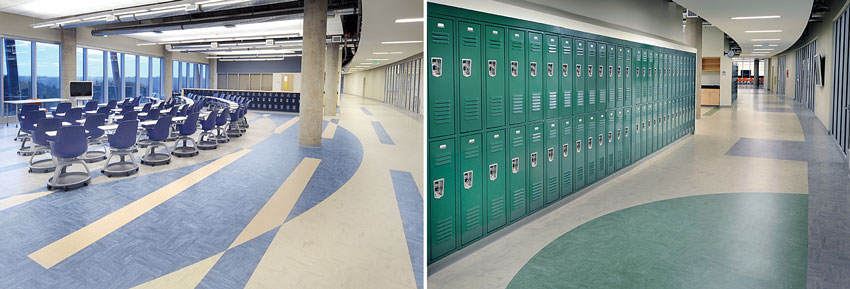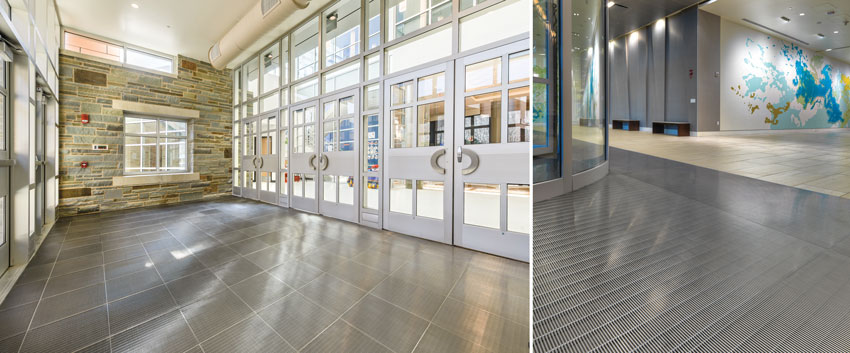Innovations in Flooring
Common Flooring Choices
The possible choices in finish flooring are extensive. Selection can be based purely on aesthetic considerations, performance concerns, green building requirements, or some combination of any or all of the above. With that in mind, let’s look at some of the innovative choices currently available.
Tile and Stone
The use of tile and stone for flooring is centuries old, and the available choices reflect that history. The properties and attributes of each of these materials are well-known, and the range of colors, textures, and patterns is impressive. One of the recent innovations here is the use of large-format porcelain tile (officially known as gauged porcelain tile/panels/slabs) made possible by modern manufacturing equipment and processes that can consistently produce quality products. Directly related to this innovation has been the need for new lightweight mortars designed specifically for large tile installations. Accordingly, manufacturers of adhesive mortars (i.e., different from producers of tile and stone) have developed specific formulations designed for large, gauged porcelain tile/panels and large-format tile and stones, for both floors and walls. Such mortars can prevent slippage of the large tile once it is in place, while providing exceptional bond strength over the full area of the tile.
Whether large format or not, all tile and stone work is dependent on the quality and makeup of the mortar, grout, and other products that are necessary for a successful installation. Identifying a manufacturer that offers a comprehensive line of high-performance flooring installation products is important to meet the needs of flooring, whether for interior or exterior applications for commercial or residential buildings. Some offer a significant warranty to cover a professional installation based on following manufacturers’ guidelines and recommendations. Many such mortars and grouts are proven around the world in virtually every climate and application where tile and stone are used. Their ease of use, strength, and durability help architects bring designs to life knowing that they will perform well over time.

Photos courtesy of LATICRETE
Tile and stone work is a common choice for commercial flooring, but its performance is directly dependent on the choice of adhesive mortars and grouts used for installation.
Resinous Flooring
Resinous flooring is essentially a durable coating over concrete that offers many benefits to owners and specifiers. There are several types, including epoxies, acrylics, and urethanes, but one of the more innovative options is referred to as a polyaspartic concrete coating. Polyaspartics are seamless, high-performance polymer coatings designed for protection that are often viewed as a variation or type of polyurea coating. They were first developed in the early 1990s as a protective coating for steel bridges subject to harsh outdoor environments. Today, polyaspartic coatings are widely used in protective resinous concrete floor coating applications, both interior and exterior. Generally, any type of environment where a resinous concrete floor coating is called for, a polyaspartic coating system may be used. This includes heavy-traffic industrial and commercial flooring as well as residential garage floor coatings.
One of the primary benefits to polyaspartic coatings is the versatility of the material. Common coating systems can be selected from standard solid colors for industrial floors, but seamless flake and monolithic quartz flooring systems are also common. Recently, new decorative floor coating applications, such as dye and seal and metallic floor coating systems, have been developed. From a performance standpoint, based on empirical testing data, polyaspartic coatings offer abrasion-resistant capabilities that exceed those of typical epoxy systems. During installation, polyaspartic coatings may be applied with a squeegee, seal-coat broom, or even a simple nap roller and will dry in a matter of hours, allowing use of the floor the next day. And, depending on the formulation, polyaspartics may be applied in extremely low temperatures below 32 degrees Fahrenheit (0 degrees Centigrade).
All resinous floorings, such as polyaspartics, provide significant benefits to a building project. The first is the ability to be a visually attractive, decorative concrete option that can be customized in appearance and finish. At the same time, it is a very durable choice that can be formulated for dramatic wearability and resistance to harsh conditions. This includes formulations that are resistant to chemicals that can cause stain or other damage that may be present in a facility. Of course, it is important to remember that a floor coating is only as good as its adhesion to concrete. Typically within the industry, concrete floor coating adhesion is measured with a pull test that provides a PSI reading, with concrete fracturing at 400 PSI of pull force. Coatings at or above this reading are recognized as having optimal substrate adhesion. From a user perspective, resinous floorings can achieve slip-resistance factors that are consistent with The Americans with Disability Act or other accessibility standards. Finally, related to floor maintenance, investing in a proper concrete floor coating can make floors easier to clean, which is particularly beneficial for high-traffic areas. Such maintenance can be enhanced when resinous coatings are applied up the base of a wall, allowing for a cove or seamless transition between the wall and the floor, thus eliminating joints or seams where dirt and bacteria can thrive.

Photo courtesy of LATICRETE
Resinous flooring, including polyaspartic coatings, provide a durable, attractive way to finish concrete surfaces.
Resilient Flooring
Resilient flooring includes a range of materials that are characterized by their ability to take some pressure or force and “bounce back” from that force to look as good as new. These include things like vinyl composition tile (VCT), vinyl sheet goods, PVC flooring, or rubber products. Sometimes overlooked in this category is linoleum, which was first invented in 1860 and has always been considered to be an excellent, inexpensive material for high-use areas. It has enjoyed a resurgence in use lately because of its use of all natural and mostly bio-based ingredients, making it a very sustainable choice. These ingredients include rosin tapped from pine trees, linseed oil obtained by pressing the seeds of the flax plant, wood flour made from timber grown in controlled forests, cork flour made by grinding the bark of the cork oak, and limestone found all over the world in enormous quantities. Added to this combination, ecologically responsible pigments are selected to create a wide range of attractive colors, while backing material, including webbing for the linoleum, can be made from natural jute grown as a renewable material.
Linoleum-finished products using these natural ingredients commonly include sheet, tile, and specialty floor coverings that are very well suited to the needs and demands of a healthier, safer indoor environment. That is in part because it is easier to clean and care for than other resilient flooring alternatives. But another important characteristic is its ability to provide natural antimicrobial functions without using any pesticides or biocides. Linoleum is made of natural ingredients that resist microbial growth by their very nature.
There are some practical benefits from installing linoleum as well. The nature of the product is that pieces seal tightly together, meaning that seam welding is not required, thus saving time and cost in installation. Linoleum also outperforms vinyl and rubber in dimensional stability, hygienic protection (when properly installed with net fit seams), and resistance to topical moisture. Linoleum is occupancy ready at installation and half as expensive to maintain, freeing maintenance staff to focus on other work. In terms of durability, the 25- to 40-year service life of linoleum far outperforms vinyl or rubber.

Photos courtesy of Forbo Flooring Systems/Fred Gerlich Photography
Resilient flooring made from linoleum provides color, design flexibility, durability and the green building benefits of all natural and renewable materials.
Entrance Flooring
Too often, one of the most overlooked and underappreciated products within a building is an entrance flooring system, which is an engineered mat or grid flooring system designed to trap dirt and debris at the door. They’re usually the last products to get installed, and one of the first products to get value-engineered off the project. However, they are one of the most functional and cost-saving products that can be included in a building relative to their overall cost. That is because entrance flooring stops dirt at the door, thereby reducing the damage it can do when tracked over other flooring systems and greatly reducing maintenance costs. It also improves indoor air quality by reducing airborne particles and the need for harsh cleaning chemicals. Since it can trap rainwater too, dangerous conditions like slippery floors can be reduced, thus helping to eliminate slip-and-fall accidents. There is a wide range of entrance flooring products available, so selections can be made to suit different building types, usage, and budgets, all while contributing to a positive first impression at doorways and entrances.
Permanent entrance flooring systems have been manufactured and incorporated into buildings since the 1960s, so they have proven themselves repeatedly over time. Products include systems that are made from aluminum or stainless steel with common choices of computer-milled, modular mats, and grids. There are options for both surface-mounted systems that sit above a concrete floor and recess-mounted applications that require that the concrete slab be formed to accept it. Most manufacturers will provide technical assistance during the design phase to assure proper sizing coordination, product samples, and other details. Through this collaboration, products can be selected that are best suited to different building types and design factors, such as weather, foot traffic, rolling loads, and ADA compliance. It allows architects and designers to gain insights into addressing the complexities of proper space layout and product choices for different applications. It also helps determine which aesthetic options and materials will best suit the overall design intent to either blend with the surrounding flooring or provide a visual accent. Once the project moves from design into construction, the manufacturing team can assist with field-verified dimensions, onsite technical support, product mockups, and sample coordination.
The value of entrance flooring systems is most fully realized by the building owners and maintenance staff. If these systems are not included, then many owners resort to hiring a laundry service to bring in portable, roll-out floor mats that need to be washed and replaced routinely depending on the conditions. That solution simply traps as much water and dirt as the mats will hold, often creating saturated, overloaded conditions that overflow onto the rest of the flooring. The cost of this ongoing maintenance can quickly exceed the cost of installing a proper entrance mat system in the first place. Wade Brown, senior product marketing manager of Construction Specialties, notes, “If entrance flooring systems are not designed and included at the time of construction, it becomes the owner’s problem to solve how to best keep dirt and water from entering through their front door, and ultimately protect all the building’s occupants from hazards, such as slips/falls and poor indoor air quality. The architect’s decision on what products to use, or whether to use them, can have a lasting effect on those who inhabit the building over its life time.” Overall, by stopping dirt at the entrance, the rest of the building thrives. Since entrance flooring systems are known for their durability with systems that stand up to years of foot traffic, heavy equipment, harsh weather conditions, and tracked-in debris, it is easy to see why they have very favorable payback periods.

Photos courtesy of Construction Specialties
Entrance flooring systems can be incorporated into buildings to trap dirt, debris, and water from entering the rest of the building while being fully integrated into buildings, such as at Owego Elementary School in Owego, New York, (left) and the Westin Denver Airport in Denver (right).
Notice

www.c-sgroup.com/floorometry

www.forboflooringNA.com

www.laticrete.com

www.newmill.com









